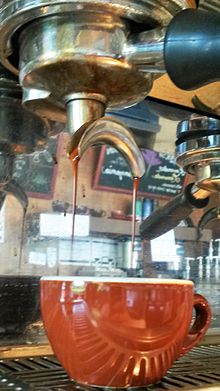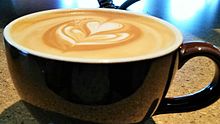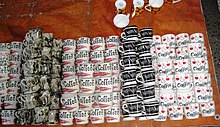Coffee cup

A coffee cup is a container, a cup, for serving coffee and coffee-based drinks. There are three major types: conventional cups used with saucers, mugs used without saucers, and disposable cups. Cups and mugs generally have a handle. Disposable paper cups used for take-out sometimes have fold-out handles, but are more often used with an insulating coffee cup sleeve.
Coffee cups and mugs may be made of glazed ceramic, porcelain, plastic, glass, insulated or uninsulated metal, and other materials. In the past, coffee cups have also been made of bone, clay, and wood.[1] Disposable coffee cups may be made out of paper or polystyrene foam (often mistakenly called Styrofoam).
History
Coffee cups, along with other coffee ware, originated in the Middle East. In the 17th century, coffee was consumed from small handle-less bowls, "Turkish cups". The cups were manufactured in Japan and China; the same cups were frequently intended for coffee and tea. In Europe, Meissen porcelain cups appeared around 1710,[2]: 230 with large exports of "Turkish cups" to Turkey in the 1730s. These cups were tall due to the habit of drinking the liquid layer at the top, with the preparation sediment left at the bottom. As the drip coffee, invented in France in the 18th century, gained popularity, the need for tall cups disappeared, so the Sèvres porcelain signature cups were short.[2]: 232
The porcelain handles first appeared on the Meissen tall cups in the 1710s (some Oriental cups had handles, but these were made from silver). Handles became common by the 1730s.[2]: 232
Shapes and sizes
Espresso
The Italian Espresso National Institute recommends serving espresso in a white china cup holding 50−100 ml,[3] usually served on a saucer. In the US, espresso cups are sometimes called demitasse cups.[4] The espresso macchiato, made with a shot of espresso and a dash of steamed milk, is also served in a demitasse.
Cappuccino

The Italian Espresso National Institute recommends serving cappuccino in a china cup holding approximately 160 ml,[3] usually served on a saucer.
Gibraltar or cortado
Some shops serve a cortado in a 4-ounce Libbey Gibraltar glass, calling the drink a Gibraltar.[5]
Sini
Traditional Ethiopian cups are called sini. These are small, pottery or porcelain cups, slightly larger than a demitasse, used to serve coffee from a jebena.[6]
Cafe drinkware

Cafes use various sizes of coffee cups to serve mochas, lattes, and other coffee drinks. They are typically 225, 336, 460, and sometimes 570 ml.[dubious ] These cups are made of porcelain and shaped to encourage and aid in creating latte art.
Shape innovation
NASA designed "Space Cups" for use by astronauts in the International Space Station. The specially-shaped coffee cups are 3D printed and are used by sucking the liquid out of a bag. The sharp inner corner of the Space Cup allows the liquid to flow toward the drinker's lips through capillary flow. Data from experiments conducted with Space Cups can be used to design better fluid systems used in space, such as toilets, oxygen, air conditioning, and water coolants. The data can also be applied to societal uses of fluid systems on Earth, such as improving the design of portable medical blood testers for infectious diseases.[7]
Materials


Porcelain and ceramic
Porcelain and ceramic cups are widely used for coffee. Ceramic is sturdier, cheaper than porcelain, and retains heat better because it is thicker.

Paper
Paper cups are usually lined with wax or plastic to prevent leakage. A famous design of a paper coffee cup is the Anthora, which has become symbolic of New York City's daily life.[8][9]
Bamboo
Reusable bamboo coffee cups, promoted as a "natural" product, are made of powdered bamboo fibres suspended in glue containing melamine and formaldehyde. The German consumer group Stiftung Warentest raised concerns that these substances constitute a health hazard when used for hot drinks.[10] The cups are also not recyclable. The UK Food Standards Agency advised retailers in June 2023 to withdraw bamboo cups, making further sales unlawful.[11]
Polystyrene
Polystyrene, sometimes known as styrofoam (not actually Styrofoam), is used mainly because of its insulating abilities.
Accessories
Coffee cup lids
Usually made of plastic, the first patent for a coffee cup lid design was filed in 1967 and focused on creating a tight seal between the cup and the lid to reduce leaking and a vent hole to allow steam to escape.[12][13][14] However, there was no opening for drinking, and the consumer would have to tear into the lid.[15] In 1986, the Solo Traveler lid was created; it is found in the Museum of Modern Art's 2004 exhibit "Humble Masterpieces".[16][17] Recent lid designs like the Viora have improved on Solo Traveler's design, which has too small a vent to allow sufficient air to enter while drinking.[13] Louise Harpman, co-owner of the world's most extensive collection of coffee cup lids and co-author of the book Coffee Lids (Princeton Architectural Press, 2018), suggests that coffee cup lids "represent a major shift in American 'to-go' culture".[18]
Coffee cup sleeve
Coffee cup sleeves are roughly cylindrical sleeves that fit tightly over handle-less paper coffee cups to insulate the drinker's hands from hot coffee. The coffee sleeve was invented and patented by Jay Sorensen in 1993 and is now commonly utilized by coffee houses and other vendors that sell hot beverages dispensed in disposable paper cups. Coffee sleeves are typically made of textured paperboard, but can be made of different materials.
Environmental issues with disposable cups
The United States uses about 120 billion disposable coffee cups annually, almost all of which end up in landfills.[19] Polystyrene foam cups have the reputation of not being recyclable,[20] non-biodegradable,[20][21] a major part of marine litter,[22] and has various health risks. It is banned as a food and drink container in several U.S. cities including Portland, Ore., San Francisco, Calif., and Amherst, Mass.[23] The doughnut company and coffeehouse chain Dunkin' Donuts has been criticized for continuing to use styrofoam cups. The company has argued that there is no other material that is as insulated,[24] and has an official statement about their foam cups on their website.[25] However, in 2013 they began phasing in doubled-walled paper cups designed to look like their signature foam cup.[26]
Polystyrene foam cups are easier to recycle than the alternative, paper coffee cups, which are lined with polyethylene to make them impermeable. The few composting facilities which do accept them produce plastic fragments, contaminating the environment,[27] and biodegrading very slowly.[27] Paper coffee cups also release trillions of microplastic nanoparticles per liter into the water during normal use.[28][29]
Reusable cups
By 2019, coffee shop customers increasingly used reusable coffee cups as a sustainable option; shops were offering a discount as an incentive.[30] Cups made of bamboo fiber, polypropylene, and other organic materials such as starch and paper pulp were used. Only 1 in 400 single-use cups were recycled in 2017, and media coverage encouraged consumers to look for alternatives.[31] Use of reusable cups declined sharply to reduce the chance of infection with the onset of the covid pandemic in 2020, and as of 2023 had not returned to previous levels.[32]
See also
References
- ^ "History of the Coffee Mug". wholelattelove.com. Whole Latte Love. 2019-09-01. Archived from the original on 2023-10-01. Retrieved 2019-08-24.
- ^ a b c Sakuraba, Miki (2010-03-31). "Evolution of Porcelain Tea Ware in Europe From Hizen Porcelain Tea to European Porcelain Tea Service" (PDF). Cultural Reproduction on its Interface: From the Perspectives of Text, Diplomacy, Otherness, and Tea in East Asia. The International Academic Forum for the Next Generation. Vol. 1. Translated by Heaton, Jenine. Institute for Cultural Interaction Studies, Kansai University. pp. 227–242 [230, 232]. ISBN 978-4-9905164-0-6. Archived (PDF) from the original on 2023-10-01. Retrieved 2023-10-01. p. 232:
Large quantities of coffee pots and cups were exported from Meissen to Turkey in the 1730s. It is clear from this fact that early European porcelains were directly related to Turkish tea wares, indicating that the Turkish cup strongly influenced the manufactories of Meissen. These cups were tall in relationship to their width and were designed because of the Turkish custom of drinking the clear layer of coffee at the top. In France at the beginning of the eighteenth century, however, the drip method of extracting coffee was developed, thus eliminating the need for tall coffee cups. Perhaps as a result, the short coffee and tea cups became the signature style of Sèvres Porcelain.
(16 pages) - ^ a b "The Certified Italian Espresso and Cappuccino" (PDF). Istituto Espresso Italiano.
- ^ Oxford English Dictionary, updated 2022, s.v. demi-tasse
- ^ Nguyen, Tien (2011-02-10). "Drink This Now: Cognoscenti Coffee's On-the-Menu Cortado". LA Weekly. Retrieved 2020-12-19.
- ^ "Coffee time Ethiopian coffee pot jebena and Coffee Cups-sini". Pinterest. Retrieved 2023-03-23.
- ^ Regan, Helen (2015-05-04). "Astronauts Now Enjoy Espresso Out of Special Cups". Time. Retrieved 2015-05-06.
- ^ Fox, Margalit (2010-04-29). "Leslie Buck, Designer of Iconic Coffee Cup, Dies at 87". The New York Times.
- ^ "Urban History to Go: Black, No Sugar". The New York Times. 2005-06-26.
- ^ "Die meisten setzen hohe Mengen an Schadstoffen frei" (in German). Stiftung Warentest. 2019-07-23.
- ^ Ungoed-Thomas, Jon (2023-10-21). "Warnings over 'eco' coffee cups that pose risks to health with toxic resin". The Guardian.
- ^ Garber, Megan (2011-05-09). "The Rise of the Plastic, Disposable Coffee Cup Lid - Nicola Twilley". The Atlantic. Retrieved 2014-05-20.
- ^ a b "To-Go Cup Lid Makers Hoping to Capitalize On 'Third Wave' Success". Roast Magazine. 2014-05-02. Retrieved 2014-05-20.
- ^ "Patent US3421681 - Cup and lid - Google Patents". Retrieved 2014-05-20.
- ^ Kennedy, Pagan (2013-10-25). "Who Made That Coffee Lid?". The New York Times.
- ^ "Patent US4589569 - Lid for drinking cup - Google Patents". 1983-10-24. Retrieved 2014-05-20.
- ^ "Humble Masterpieces". MoMA. 2004-09-27. Retrieved 2014-05-20.
- ^ "History, Travel, Arts, Science, People, Places". Smithsonian. Retrieved 2014-05-20.
- ^ Bhattacharyya, Jishnu; Dash, Manoj Kumar; Hewege, Chandana; Balaji, M. S.; Lim, Weng Marc (2021-09-26). "Social and Sustainability Marketing in Coffee Shop". Social and Sustainability Marketing: A Casebook for Reaching Your Socially Responsible Consumers through Marketing Science. CRC Press. p. 853. ISBN 978-1-000-40802-7.
- ^ a b "Drinking Coffee in a Styrofoam Cup? Pour It Out". Rodale News. Archived from the original on 2013-07-07. Retrieved 2014-05-20.
- ^ Bandyopadhyay, A.; Basak, G. Chandra (2007). "Studies on photocatalytic degradation of polystyrene". Materials Science and Technology. 23 (3). Maney Online: 307–314. Bibcode:2007MatST..23..307B. doi:10.1179/174328407X158640. S2CID 137115006.
- ^ "Marine Litter". kimointernational.org. Archived from the original on 2013-03-23.
- ^ Daneman, Matthew (2013-12-21). "More cities ban polystyrene foam, citing environment". USA Today.
- ^ "Dunkin' Donuts Opposes Proposed Somerville Styrofoam Ban". Somerville, Massachusetts Patch. 2013-02-28.
- ^ "FAQs". DunkinDonuts.com.
- ^ "Dunkin' Donuts introduces paper coffee cups in Brookline - Business". The Boston Globe. 2013-08-19.
- ^ a b Brinton, Will (April 2016). "The Environmental Hazards Inherent in the Composting of Plastic-Coated Paper Products" (PDF).
- ^ "Take-out coffee cups may be shedding trillions of plastic nanoparticles, study says". UPI. Retrieved 2022-05-14.
- ^ Zangmeister, Christopher D.; Radney, James G.; Benkstein, Kurt D.; Kalanyan, Berc (2022-05-02). "Common Single-Use Consumer Plastic Products Release Trillions of Sub-100 nm Nanoparticles per Liter into Water during Normal Use". Environmental Science & Technology. 56 (9): 5448–5455. Bibcode:2022EnST...56.5448Z. doi:10.1021/acs.est.1c06768. ISSN 0013-936X. PMID 35441513. S2CID 248263169.
- ^ Marcus, Rebecca (2019-11-23). "Five reasons why you should switch to a reusable coffee cup". Which?.
- ^ "Just one in 400 coffee cups are recycled even if you put them in recycling bin, poll finds". The Telegraph. 2017-04-06.
- ^ Houghton, Amy (2023-03-08). "Why did we give up on the reusable coffee cup?". Time Out United Kingdom.
- CS1 German-language sources (de)
- Articles with short description
- Short description is different from Wikidata
- Use dmy dates from May 2023
- All accuracy disputes
- Articles with disputed statements from January 2023
- Commons category link is on Wikidata
- Articles with J9U identifiers
- Articles with LCCN identifiers
- Coffeeware
- Coffee culture